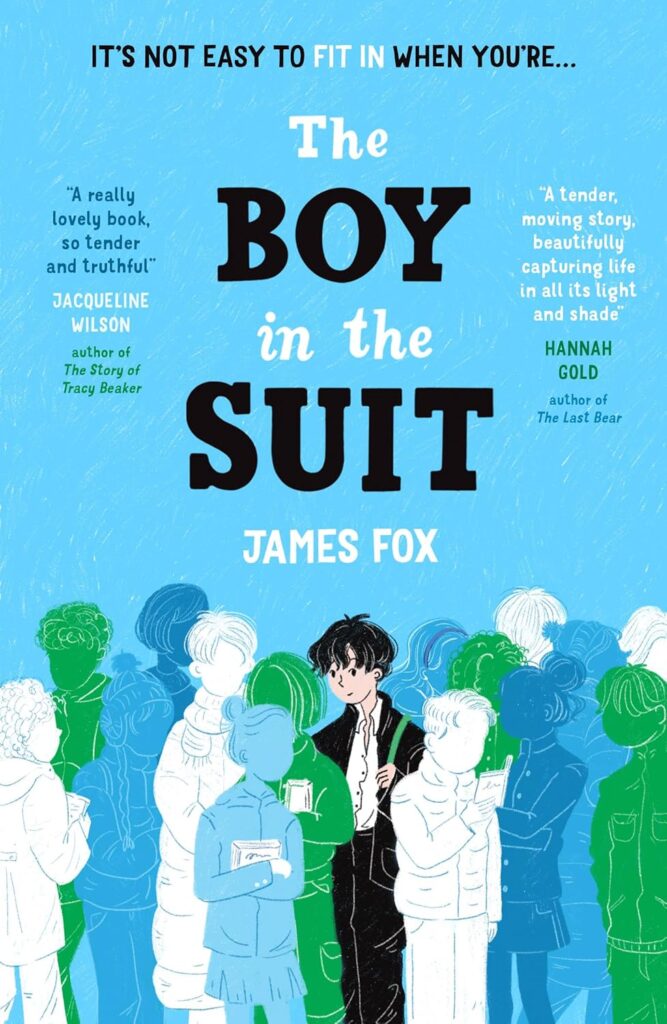By James Fox (Scholastic, 2024)
I pulled again on Morag’s wrist, so hard I felt my veins popping out of my forehead. Why couldn’t they just let her go? I wished Morag and I had the power to turn invisible. I wanted us to run away and forget all about this stupid funeral.
That’s when the camera flashed. Bright white, right in our faces. “Oh dear,” a man’s voice sneered. It was the newspaper photographer from earlier. “What’s going on here, then?”
Ten-year-old Solo and his mum, Morag, have been having a rough time of it recently. Morag suffers the “Big Bad Reds” that make her lash out and with the loss of her job, they’re struggling for money. Morag insists that they’re managing, and everything will be fine, but Solo isn’t so sure.
Recently, Morag has got into the habit of sneaking into funerals, taking Solo along with her so they can bag up the free food while no-one is looking – and so Morag can enjoy the free drinks. But then one day they crash the wrong one, and suddenly their picture, and lives, are broadcast all over the front page of The Herald.
Solo gets enough trouble at school already, being stuck in his funeral suit as Morag hasn’t got him a uniform yet, but his problems are only just beginning. Maybe the new girl Chetna, the only kid at school who talks to him, can help him open up…

I’m going to start by saying that The Boy in the Suit is not the most comfortable read – but that makes it all the more important. It deals with difficult themes such as mental health, alcoholism, broken homes, and cost of living; themes that we should be talking about, especially to help younger readers understand them.
It’s easy to think that a child of that age shouldn’t be exposed to these kind of issues, but the truth is that some are, no matter how many pearls we clutch. And we do them no favours by not explaining or discussing them, whether we do it to protect them or for some other reason. Solo doesn’t understand what’s going on, which means he keeps asking questions that annoy Morag further.
For Morag though, it’s not necessarily – or just – about protecting Solo, but rather her stubbornness, her refusal to admit that she needs help. And this is what she’s passing onto him, intentionally or not. Morag tells him that he mustn’t tell people about their problems, that they can manage, that you can’t trust people, and that they’ll be separated if people find out. And he takes this message to heart, meaning he has no actual friends until the new girl arrives.
Although being accepted onto the “Cool Table”, Chetna is far more interested in working with Solo. And it’s not out of pity; rather there is a genuine interest in spending time with him. She’s somewhat blunt and nosy, but also kind and optimistic – this combination is exactly what Solo needs, even if he doesn’t know or believe it!
Throughout the book he is approached by his teachers who, as they find out more about his home life, try to offer help and guidance. But Solo refuses to talk to them and keeps pretending that everything is fine, just like Morag does. This behaviour is drilled into him, and it’s heartbreaking.
Morag is, understandably, a frustrating character. She’s not evil, she’s spiralling into a mental health crisis, and it can be easy to dismiss how these can look; it’s not always crying breakdowns, sometimes its destructive behaviour that they even seem to enjoy. The difference here though is that she is dragging an innocent child along with her. Bad behaviour can be caused by mental health issues, but that doesn’t make it right or okay.
Although Morag loves Solo dearly, her treatment of him essentially qualifies as abuse. Oh, there’s no violence, but the mental and emotional anguish she puts him through throughout the book, and before it starts, is more than any adult or child should have to bear. It’s a good reminder that mental health affects loved ones as well, not just the person in question.
The story shows how important it is to reach out to people and get help, but also that it must be the person themself who takes the final step. Although the care of Solo can be forced out of Morag’s hands, improving her own mental state cannot. It’s a decision she must take for herself.
It also impresses upon us how there is often more going on underneath someone’s façade than we realise – as many of the adults come to find out. Solo has been dismissed and judged, and its only with the newspaper article that people start to realise how much he’s been suffering. It’s no surprise that by then he’s unwilling to talk about things. But it’s important to be there for these people for when they do feel they can open up.
Finally, it’s a touching reminder to “look for the helpers” (I never watched Mr Rogers, but I believe his messages are important). For children who may experience something similar, it shows them that they can – and should – reach out to another adult for help. And for those who thankfully don’t see themselves in the book, it can show them how to empathise and understand those who might be going through something they can’t possibly imagine.
All in all, The Boy in the Suit would be an excellent starting point for discussions around mental health, and how it intersects with issues such as austerity, alcoholism, and parenting. There is a list of relevant charities at the back, which can provide more information for those who want to know more, or who need support.
This is a cracking debut from Fox, providing a moving and thought-provoking portrayal of mental health and a genuine lesson about showing compassion and taking the time to connect with others. Its tender but honest message about seeking help when struggling is an important one for children and adults of all ages.
If you want to make this emotional journey with Solo, you can grab a copy of The Boy in the Suit at the link below.
(Disclosure: If you buy books linked to our site, we may earn a commission from Bookshop.org, whose fees support independent bookshops.)
Looking for more young adult reads? Check out some of our previous book reviews here.

